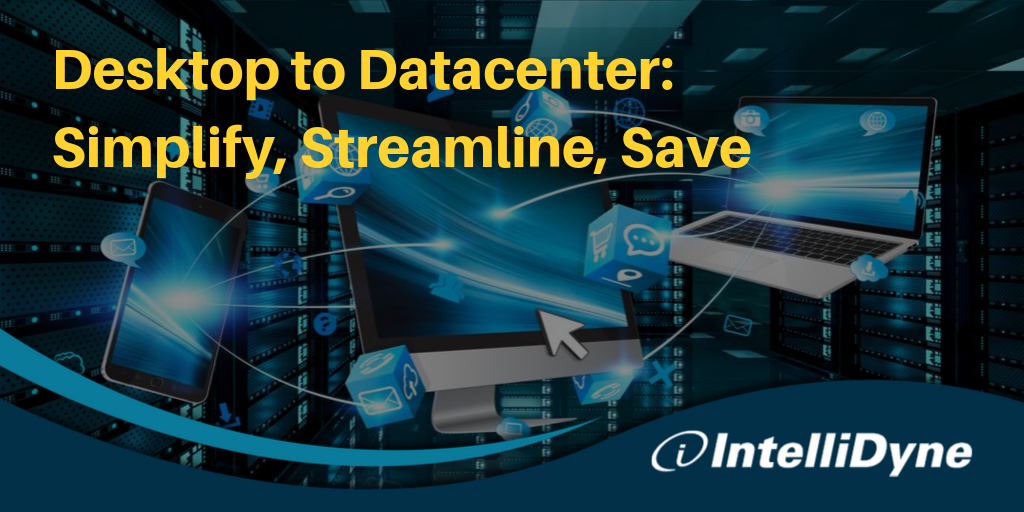Desktop to Datacenter (D2D) migration isn’t just a necessity in today’s always-advancing, tech-driven world — it’s a huge advantage for any type of enterprise, government or commercial. A datacenter is nothing more than a group of networked servers configured to allow for remote storage, processing and distribution of data. The larger the organization and the more complex its needs, the more robust the datacenter has to be, whether on-prem, off-site, cloud-based, or hybrid model.
Datacenters range greatly in their architecture and requirements but include: the facility or space where the data will be housed; support infrastructure; uninterruptible power sources; environmental control; the actual IT equipment; 24/7 security and an IT operations team. Datacenters have evolved to encompass virtualization technologies, with LAN/WAN services, Active Directory (AD) and Domain functionality, and proactive security in the form of monitoring and incident prevention, data encryption during transmission, and redundant back-up storage.
Moving from a desktop model to a centralized enterprise support model can drastically reduce the hardware footprint across an enterprise, simplify data center management, reduce total cost of ownership (TCO), improve efficiency and resource allocation, augment disaster recovery and business continuity functionality, and make it easier to deploy new systems to meet changing business requirements. Add to that cloud technologies such as Software as a Service (SaaS), and instead of updating hundreds or thousands of machines many times over, you make a change once and it’s deployed across the enterprise.
The Benefits Outweigh the Angst
Datacenter virtualization also saves an enormous amount in terms of hardware and software costs. From purchasing physical servers including CPU(s) and/or RAM, to having a smaller datacenter footprint, virtualization reduces physical overhead. Benefits of datacenter virtualization include:
- Reduced hardware and software costs
- Savings on energy costs such as HVAC, electricity, physical space, and other utilities
- Increased effectiveness, efficiency, agility and responsiveness with administration
- Increased server provisioning and deployment speed
- Minimized or eliminated downtime
- Improved disaster recovery and business continuity
- Simplified data center management
- Eliminated redundancy and streamlined operations with a cloud computing-based infrastructure using virtualization technology
- Improved end-user experience, enabling secure connection from anywhere in the world on any device through dynamic provisioning
- A scalable solution — new components can be added easily
Migrating from desktop to datacenter certainly streamlines and simplifies operations, but the process itself is not simple. It’s a multi-step, and even a multi-year process depending on the complexity of the enterprise IT environment. The process involves IT planning and architecture, system engineering and development, cybersecurity/IA, infrastructure support, and O&M support, along with contract planning, project management, budgeting, risk management, quality control, financial management, and strategic consulting and service delivery.
Many Considerations, But First 2 Key Questions
Before you dip a toe into D2D transformation, there are many things to consider and think through, and many questions you should ask of yourself and your team. Here are just two:
Do you have a realistic timeline with detailed steps for each phase?
Each step must be carefully scheduled, from pre-deployment activities to enterprise-level central management. Even just to start, you should be ready to do a full survey of your IT enterprise, standardize desktop and network configurations, and move all sites to a common operating system.
Do you have a plan to handle scheduled downtime?
While some downtime may be inevitable when undertaking a full datacenter migration, a robust plan can help ensure that your downtime is scheduled and minimizes disruptions. That’s critical if you have a multi-site organization. In which case, you’ll need to plan for risk factors involved with geographically separated units (GSUs), especially if multiple sites will be migrated at the same time. To be successful, you’ll need end-to-end planning and execution, from design to implementation.
3-Pronged Approach: Stabilize, Optimize, and Innovate.
You can see why having a partner with a depth of D2D experience like IntelliDyne is essential. For a large government agency, IntelliDyne provided infrastructure management spanning many different sites. We relocated and co-located multiple IT environments into a single site, with shared IT infrastructure, operations and services. Our team first assessed each system to stabilize services, ensuring no disruption in operations. Then we applied our consolidation and technical solutions to optimize service. Finally, we began innovating, applying cloud, virtualization, and network improvements. We planned and executed the simultaneous modernization and migration, evaluated capacity requirements, and provisioned secure services for each organization in the new multi-tenant environment. And, we installed our enterprise advanced analytics tool, DashBlox®, which added transparency while delivering more consistent and predictable support services.
IntelliDyne has consolidated datacenters with zero unplanned downtime, upgraded thousands of end-users to Windows 10 ahead of schedule, and built centralized content management systems that enabled millions of dollars of IT resources to be reallocated.
Want to learn more about our D2D services, or discuss a potential initiative? Message us or call us at 703-575-9715.

